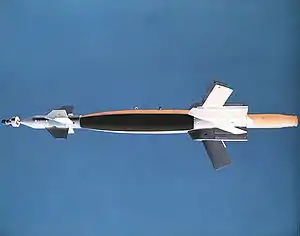| AGM-123 Skipper II | |
|---|---|
 | |
| Type | Rocket assisted, low-level, laser-guided bomb |
| Place of origin | United States |
| Service history | |
| In service | 1985-1990s[1] |
| Used by | United States Navy, United States Marine Corps |
| Production history | |
| Manufacturer | Emerson Electric |
| Specifications | |
| Mass | 582 kg (1,283 lb) |
| Length | 4.3 m (14 ft 1.2 in) |
| Diameter | 0.5 m (1 ft 7.6 in) |
| Wingspan | 1.6 m (5 ft 3 in) |
| Warhead | 1000 lb (450 kg) Mk 83 bomb |
Detonation mechanism | Impact-fuse |
| Engine | Aerojet Mk 78 dual-thrust solid-fueled rocket |
Operational range | 25 km (15.5 statute miles) |
| Maximum speed | 1,100 km/h (680 mph) |
Guidance system | laser-guidance |
AGM-123 Skipper II is a short-range laser-guided missile developed by the United States Navy. The Skipper was intended as an anti-ship weapon, capable of disabling the largest vessels with a 1,000-lb (450-kg) impact-fuzed warhead.
Design
The AGM-123 is composed out of a 1,000 lb (454 kg) Mark 83 low-drag general purpose bomb fitted with a Paveway guidance kit and one Aerojet Mk 78 solid-propellant rocket that fires upon launch. The rocket allows the AGM-123 to be dropped farther away from the target than could free-fall bombs, which helps protect the delivery aircraft from surface-to-air-missiles and anti-aircraft artillery near the target.
The AGM-123 was developed at the China Lake Naval Weapons Center and was carried by the A-6E Intruder, A-7 Corsair II, and F/A-18.
Operational history
Four Skipper missiles launched by A-6E Intruders contributed to sinking the Iranian frigate Sahand during Operation Praying Mantis on April 18, 1988.[2]
Skipper missiles were also fired in Operation Desert Storm against Iraqi surface vessels by A-6s and U.S. Marine aircraft.[2]
Gallery
 An AGM-123A Skipper II low-level laser-guided missile mounted on the wing pylon of a Vought A-7
An AGM-123A Skipper II low-level laser-guided missile mounted on the wing pylon of a Vought A-7 A U.S. Navy Grumman A-6E Intruder as its crew monitors the flight of two AGM-123A low-level, laser-guided missiles
A U.S. Navy Grumman A-6E Intruder as its crew monitors the flight of two AGM-123A low-level, laser-guided missiles
References
- ↑ "Emerson Electric AGM-123 Skipper II". www.designation-systems.net.
- 1 2 "Islamic Republic News Agency" (in Persian). Archived from the original on 16 March 2012. Retrieved 20 March 2017.
External links
- Designation systems - Emerson Electric AGM-123 Skipper II
- Federation of American Scientists - AGM-123 Skipper II